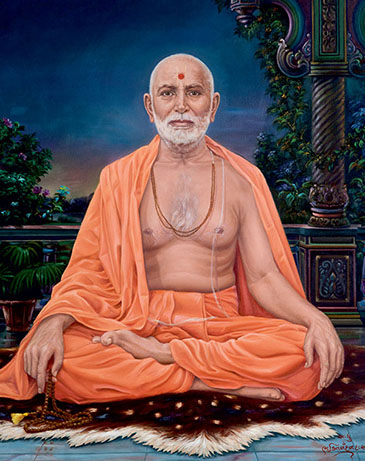
Shastriji Maharaj was the third spiritual successor of Bhagwan Swaminarayan and formalized the BAPS Swaminarayan Sanstha. Born as Dungar Bhakta in Mahelav, he was known from a young age for his strong conviction in Bhagwan Swaminarayan, His philosophy, and His spiritual successors.
Shastriji Maharaj’s true conviction was displayed in the way he lived his life, even as a child. One night, he went out to the farm in the thickness of night. Though all of the town’s children were scared to walk down the dimly lit road to the fields, Dungar Bhakta was not worried. When his father asked him why he was not afraid, Dungar Bhakta replied that he had nothing to fear if he was chanting the Swaminarayan mantra.
Dungar Bhakta displayed a sharp sense of intellect from a young age. At ten years old, he was offered a free education on the promise that he becomes an official in the British government upon completion of his education. Dungar Bhakta turned down the offer, unimpressed by the high worldly status it offered.
Dungar Bhakta was determined to become a sadhu from the first time he met with the Swaminarayan sanstha’s traveling sadhus. His father, Dhoribhai, was unwilling to let him become a sadhu despite his many requests. Finally, when he was sixteen, Dhoribhai gave Dungar Bhakta permission to become a sadhu after realizing it was his son’s only desire.
As soon as Dungar Bhakta arrived at the mandir in Surat, he devoted himself to the service of the mandir and its devotees. Soon thereafter, he was given sadhu diksha and named Sadhu Yagnapurushdas. He continued to serve the mandir and his guru and began to study the scriptures in Sanskrit. Sadhu Yagnapurushdas was given diksha by Swami Vignananand. After Swami Vigananand passed away, Sadhu Yagnpurushdas stayed in the service of Bhagatji Maharaj. He completed his studies of the scriptures and became known for his discourses on the Akshar Purushottam philosophy. He continued to excel at advanced levels of scriptural study.
Despite growing opposition by detractors of this purity and philosophical clarity, Sadhu Yagnapurushdas continued to spread the philosophy of Akshar Purushottam. His conviction in the Akshar Purushottam philosophy and faith in his guru’s words was firm and unflinching. He wished to install the murtis of Akshar and Purushottam in the center of a shikharbaddha mandir. Resistance against his ideas grew, and eventually he agreed to leave Vadtal mandir. He left with only five sadhus and a handful of devotees.
Sadhu Yagnapurushdas continued to spread the Akshar Purushottam philosophy throughout Gujarat and decided to build a mandir in Bochasan in which he could install the murtis of Akshar and Purushottam without resistance. He began to be known as Shastriji Maharaj for his unparalleled knowledge of Hindu scriptures. It was not easy for Shastriji Maharaj to build the mandir in Bochasan. Shastriji Maharaj and his sadhus continued to be beaten and threatened. However, in 1907 Shastriji Maharaj opened a mandir in Bochasan, marking the beginning of what is now the BAPS Swaminarayan Sanstha.
After opening the mandir in Bochasan, Shastrji Maharaj traveled to Sarangpur where he met with a devotee who donated land for a second mandir to be built in Sarangpur. Shastriji Maharaj and his sadhus continued to face difficult circumstances but triumphantly opened the Sarangpur mandir in 1916. In addition to building mandirs, Shastriji Maharaj began to spread the Akshar Purushottam philosophy outside of Gujarat to other parts of India and as far as East Africa.
In the following years, mandirs were opened in Gondal, Atladra, and Gadhada. The sanstha was growing quickly, and Shastriji Maharaj appointed 28-year-old Sadhu Narayanswarupdas as President of the sanstha. In 1951, after appointing Yogiji Maharaj as his spiritual successor, Shastriji Maharaj passed away in Sarangpur at the age of 86.